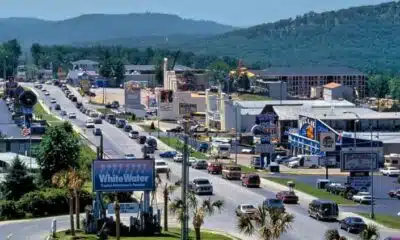News from the South - North Carolina News Feed
State health agency is ‘working to ensure public safety’ following death in Mission ER bathroom • Asheville Watchdog
The state’s top health agency is working to gather more information regarding the death of a Mission Hospital patient in an emergency department bathroom after staff did not quickly respond to his call for help.
The North Carolina Department of Health and Human Services and the U.S. Centers for Medicare & Medicaid Services (CMS) would not provide Asheville Watchdog specific information about any potential investigations but said it is consulting with CMS about the Feb. 10 death.
“First, it is critical that every person in North Carolina can get the care they need from providers and local hospitals,” NCDHHS spokesperson Summer Tonizzo said Wednesday. “One of our priorities is making sure every North Carolinian can access the care they need at the right time and in the right place.
“We are aware of the tragic death that occurred in the ED last week at Mission Hospital and while we can’t comment on possible investigations, we are working to ensure patient safety. All complaints we receive are confidential and are being reviewed by NCDHHS. The team is working to gather more information to determine next steps in consultation with CMS.”
A CMS spokesperson said the agency does not comment on ongoing or potential investigations.
Mission Health spokesperson Nancy Lindell did not answer questions about whether any investigators had visited the hospital and if leadership had made changes in staffing or training following the death. “We don’t have anything further for you,” she said.
On the evening of Feb. 10, a patient arrived by ambulance at the emergency department with a respiratory complaint or chest pain and was sent to an internal processing area.
Medical staff ordered an electrocardiogram, or EKG, for the man, but before the procedure, he needed to go to the bathroom. While inside, he pulled a call bell, but no one responded for 12-15 minutes, multiple nurses said, until a triage nurse checked the bathroom and found him dead. The Watchdog was the first to report the death on Feb. 20.
Following death, hospital fires one employee
Lindell told The Watchdog that day that Mission was investigating the incident and had fired one employee.
“Our investigation indicates that certain staff who had been trained did not follow hospital protocols,” Lindell said at the time. “We have terminated one individual and have reported to the appropriate agencies.”
Nurses told The Watchdog that they thought staffing levels were inadequate that evening and led to the man’s call not receiving an immediate response.
NCDHHS and CMS have previously investigated the hospital, focusing primarily on the emergency department. After a late 2023 investigation, they determined that 18 people were harmed, four of whom died, because of violations of federal standards of care in the emergency department.
In February 2024, CMS placed Mission in immediate jeopardy, the most severe sanction a hospital can face, threatening suspension of federal funding unless the violations were fixed. Investigators found Mission in federal compliance 23 days later and lifted the sanction.
Several emergency department nurses who spoke to The Watchdog said conditions had improved shortly after the immediate jeopardy finding. The hospital hired more staff and worked with nurses to develop emergency department management strategies, among other improvements.
But conditions declined when Mission went back to pre-2024 procedures, contracts for traveler nurses expired, nurses quit and staffing in the emergency department grew sparse again.
Nurses said they are often overwhelmed by crowded nights in the emergency department and not enough staff to immediately work with patients.
Even after the Feb. 10 death, the department is strained, according to nurses The Watchdog spoke to Wednesday.
“I was there last night,” said Alyssa Aradia, an ER nurse, discussing her Tuesday night shift. “We had 130 in the department when I got there. We never got below 95. So that’s a lot of patients. We had patients in the waiting room that were already admitted, just waiting for beds. They never even made it to an ED room. We had high acuity patients in the express pods [contained parts of the waiting area].
“The express pods turned into holding pods, and nurses had to come down from step-down units or wherever to watch them while we did stuff out of the waiting room. Some people were waiting 9, 10, 11 hours in the waiting room for a bed upstairs that were already admitted by the time I left.”
Ashley Bunting, an ER nurse who worked all day Wednesday, said there were 70 patients in the emergency department when she started at 7 a.m. and about 140 patients at max. Patients were lining the halls, Bunting said, adding that it felt like the most intense day since Tropical Storm Helene.
Bunting said it has been mostly “radio silence” from administration following the death.
Training on call bell response
Aradia said that since the death, nurses were required to complete call bell response training and now there is an “increased demand for nurses to be responsive on the radio.”
She explained this means that even if she was preparing a blood pressure medicine “to make sure somebody stays alive, and somebody wants a blanket, and I don’t answer on the radio about the fact that I heard them say that they want a blanket, I can get written up for it.”
Bunting said she saw nurses drilling for how to respond to call bells like the one the patient rang.
Nurses are demanding HCA Healthcare, Mission’s owner, staff the hospital better. For years they have contended that inadequate staffing could lead to harm and death.

“A patient may have recently died at Mission Hospital due to dangerously low staffing levels,” a National Nurses United flyer obtained by The Watchdog reads. “Nurses have been warning for months that this could happen if HCA refused to take immediate action to ensure safe staffing.”
Union nurses plan to hold a public demonstration March 6 at the hospital campus. According to the flyer, their demands include improved contracts, break relief, more staff, no more hallway beds, and additional pay for picking up extra shifts.
They also are supporting the efforts of Reclaim Healthcare WNC, a coalition of elected officials, doctors, advocates, clergy, and health care workers seeking to replace HCA with a nonprofit owner.
In response to the Feb. 10 death, the group has scheduled a news conference Friday morning during which it will “call for Mission to increase staffing levels at the hospital and provide more information about recent deaths at the hospital,” according to a news release it issued earlier this week.
Many nurses feel as though nothing has changed, despite regulatory action and community outcry.
“It just somehow feels even worse, not better,” Aradia said.
Bunting echoed her concern.
“It feels very much like our cries for help are going unanswered,” Bunting said.
Asheville Watchdog is a nonprofit news team producing stories that matter to Asheville and Buncombe County. Andrew R. Jones is a Watchdog investigative reporter. Email arjones@avlwatchdog.org. The Watchdog’s local reporting is made possible by donations from the community. To show your support for this vital public service go to avlwatchdog.org/support-our-publication/.
Related
The post State health agency is ‘working to ensure public safety’ following death in Mission ER bathroom • Asheville Watchdog appeared first on avlwatchdog.org
News from the South - North Carolina News Feed
Sister of murdered NC Green Beret shares who he was, memory from last time she saw him
SUMMARY: Clint Banell, a talented athlete and Green Beret inspired by 9/11, was tragically murdered. His sister, Stephanie Ferkins, remembers him as a passionate, loving person excelling in medicine and education. Clint married Shana Cloud, with whom he raised her daughter, but their relationship grew distant. In December, Stephanie last saw Clint happy and thriving in PA school. Months later, a torso found near their home was identified as Clint’s; Shana is charged with his murder. Stephanie firmly believes Shana is responsible and struggles daily with unanswered questions. She remains committed to seeking justice and honoring her brother’s legacy.
Stefanie Firkins says that growing up, her brother Clint Bonnell was an athlete with an artsy side. He played football but was also passionate about music and theater.
More: https://abc11.com/post/true-crime-nc-green-beret-murder-what-happened-clinton-clint-bonnell-abc11-stream-special/17109440/
Download: https://abc11.com/apps/
Like us on Facebook: https://www.facebook.com/ABC11/
Instagram: https://www.instagram.com/abc11_wtvd/
Threads: https://www.threads.net/@abc11_wtvd
TIKTOK: https://www.tiktok.com/@abc11_eyewitnessnews
News from the South - North Carolina News Feed
The North Carolinians that the “big, beautiful bill” will terrify, bankrupt, and kill
SUMMARY: President Trump’s “big, beautiful bill,” signed into law on July 4, 2025, enacts historic cuts to Medicaid and SNAP food assistance, threatening millions’ health and nutrition. Nearly 12 million Americans, including hundreds of thousands in North Carolina, face losing Medicaid coverage, with the state projected to lose \$32 billion over a decade. The cuts risk reversing recent expansions that aided vulnerable families, like Wake County’s Maddie Wertenberg, whose son’s medical costs were covered by Medicaid, and Crystal Upchurch, whose life depends on Medicaid-covered dialysis. SNAP reductions endanger food security for 1.2 million North Carolinians, intensifying hunger and poverty fears nationwide.
The post The North Carolinians that the “big, beautiful bill” will terrify, bankrupt, and kill appeared first on ncnewsline.com
News from the South - North Carolina News Feed
Locating I-40 through the Pigeon River Gorge was a bad idea, but we’re stuck with it • Asheville Watchdog
If you’re like me, you avoid driving I-40 through the Pigeon River Gorge like warm beer on a hot summer day.

Hey, if I have to circle through Georgia, Alabama, Mississippi and Arkansas to enter Tennessee from the west and then drive east back to Knoxville, I’ll do it. Perhaps I exaggerate, but that drive through the gorge to Knoxville has always been one of white knuckles, clinched orifices and prayers that speeding semis don’t topple over on you in a curve.
It’s a terrible road — windy, steep in places and remarkably prone to rockslides and landslides, as we’ve seen over the past 10 months.
Last September, Tropical Storm Helene caused the Pigeon River to swell into a raging torrent, which undermined the interstate’s lanes and caused it to shut down for five months. The NCDOT noted that the storm “washed away about 3 million cubic yards of dirt, rock and material from the side of I-40.”
It reopened with one lane in each direction March 1, but that was short-lived. Heavy rain June 18 caused a rockslide near the North Carolina-Tennessee line, and the road was closed until June 27.

These slides conjured memories for a regular correspondent of mine, who emailed me this:
“I’ve always heard that I-40 through the gorge from North Carolina to Tennessee was originally planned for a different location, but that business people in Waynesville urged that it go where it is today — despite geo-engineers concluding that route was not optimal and potentially dangerous. Is that version true, or a myth that’s seeped into local lore? Please help us all with the history and backstory of the current route, one that is creating so much consternation and harm to the region. Did it have to be designed this way?”
It’s a salient point, mainly because in the 30 years I’ve been here, slides in the gorge have been about as commonplace as someone firing up a spliff on an Asheville sidewalk.
Neither gorge nor French Broad River routes were great
Not surprisingly, much has been written about all of this, including a 2009 story I wrote for the Citizen Times in which I quoted several sources who said the Pigeon River Gorge posed known geologic problems and was prone to sliding even during construction. Jody Kuhne, a state engineering geologist with the NCDOT, provided a particularly colorful interview.

“Lots of people these days will say highway decisions are all politics — well, hell yes, they are,’” Kuehne said. “Back at that time, Haywood County had a large paper mill, major railroad access and other industry, and Madison County just didn’t have that, except some in Hot Springs. So sure, they out-politicked Madison. The road went where the action was.”
Ever since North Carolina had passed a law in 1921 stating that all counties should have a road that connects their county seat to neighboring county seats, people in Haywood had pushed for a road to the next county west, in Tennessee. Initially, the proposal was for a two-lane road, but that changed when Dwight Eisenhower became president in the 1950s and pushed for the interstate program we have today.
Haywood business leaders and politicians wanted the interstate to come their way; leaders and politicians in Buncombe and Madison counties wanted the road to follow the French Broad River where 25/70 runs today.
While many have assailed the Pigeon River Gorge as a terrible choice because of its geology, Kuehne told me in 2009 that neither route presented a good option.
“The Hot Springs-French Broad River route has crazy geologic (stuff) you can’t even wrap your mind around,” he said, explaining that it has rounded quartz rock.
It also has just as much low-to medium-grade metamorphic rock — which is more prone to slides — as the Pigeon River Gorge. In fact, 25-70 also has been prone to slides, but they don’t get noticed as much because of its lower traffic volume, Kuehne said.
I also interviewed retired NCDOT District Engineer Stan Hyatt for that story.
“I would say today, if we had no road through Haywood, with the advances in geotechnology, we would never try to build an interstate type road down there, unless there was just no place else to put it,” Hyatt said. “It’s just an area that’s full of nothing but fractured rock waiting to fall off.”

This was well known during construction and in 1968 when I-40 opened. An October 1968 Citizen-Times article quoted a Tennessee engineer who said, “It seemed like the rock and dirt had been oiled. We would blast it out, level it, ditch it, and then it would slide almost before we could get the machinery out of the way.”
The reporter noted presciently, “Engineers from both Tennessee and North Carolina said that slides would probably be a major problem along the route for many years.”
And they have been. The area has seen dozens of slides over the years, including some that shut I-40 down for months.
Was it political? Yes, no, maybe, probably…
Sussing out the politics of all this is more difficult, as they go back to the 1940s, ‘50s and ‘60s.
Adam Prince, who runs the blog Gribblenation, wrote a fine, well-footnoted piece about the gorge and I-40’s troubled history a month after Helene. He noted that, “I-40’s route through the Pigeon River Gorge dates to local political squabbles in the 1940s and a state highway law written in 1921.”
Prince wrote:
“A small note appeared in the July 28, 1945, Asheville Times. It read that the North Carolina State Highway Commission had authorized a feasibility study of a ‘…water-level road down [the] Pigeon River to the Tennessee line.’”
Prince found that a Pigeon River Gorge study, “along with a study on improving the existing US 25/70 corridor through Madison County via a water-level route along the French Broad River, was completed in late 1948.”
“The French Broad Route of US 25/70 through Marshall and Hot Springs had been the long-established travel route between Asheville and Eastern Tennessee,” Prince wrote. “Confusion on whether or not the two studies were related to each other was amplified when in December of that year, outgoing North Carolina Governor R. Gregg Cherry awarded $450,000 in surplus highway funding for the construction of the Pigeon River route.”
Construction did not follow, though, because as Prince pointed out, “it was also unknown how the route would be built.” Summer 1951 was a turning point, Prince states, as in that June “a public hearing in Asheville was held to discuss the two corridors. It was questioned if a survey of the French Broad River corridor had occurred, and the backers of that route requested another.”
In July, Gov. W. Kerr Scott awarded $500,000 toward the construction of the Pigeon River Route.
“The award cemented the eventuality of a Waynesville-to-Tennessee highway,” Prince writes. “Yet, French Broad River backers continued to push for an improved water-level US 25/70 route along that corridor.”
Two years later, the first construction project in the gorge was awarded, $1.3 million to grade 6.5 miles of “eventual roadway from the Tennessee line to Cold Springs Creek Road (Exit 7 on today’s I-40).”
Next came Eisenhower’s interstate system and lots of federal money — and more squabbling. Tennessee wanted the Haywood route, too. Prince writes:
“In 1954, Harry E. Buchanan, commissioner of the 14th Highway Division, met with Tennessee officials on how best to link the two states between the French Broad and Pigeon River routes. At a meeting of the Southeastern Association of Highway Officials in Nashville, Buchanan met with Tennessee officials — who wanted to shift the proposed Asheville-Knoxville Interstate Corridor to follow the Pigeon River.”
Tennessee officials urged the North Carolina Highway Commission to propose the changed corridor to the Bureau of Public Roads.
“The announcement immediately sparked the ire of Madison and Buncombe Counties and City of Asheville officials. The published 1947 map of proposed Interstate corridors had the Asheville-Knoxville link follow the existing US 25/70 French Broad River route.”
But, as Prince reported, “by April 1955, the North Carolina State Highway Commission had ‘tentatively confirmed’ the Pigeon River route for the new Interstate; backers of the French Broad Route then successfully delayed the final decision by urging the commission to undertake a complete study of the French Broad River corridor. The reprieve did not last long.”
Asheville engineer T.M. Howerton completed a study of two possible French Broad routes, but in June 1956 the State Highway Commission voted for the Pigeon River route. Prince states:
“While Howerton’s study pointed to a lower cost for the French Broad route by 50 percent ($15 million vs. $30 million), SHC officials estimated that the financials were the reverse, with the Pigeon River route being less expensive. They also stated the French Broad Route ‘was not feasible.’ Suspicions rose throughout the state about the Highway Commission’s decision to award without a fully sanctioned study completed.”

Ultimately, the Pigeon River route cost $33 million, Prince notes.
The road opened in October 1968. The first rockslide that would close the interstate occurred Feb. 12, 1969.
With all the maneuvering and machinations of the 1940s, ‘50s and ‘60s, it’s no surprise the notion lingered that the route choice was all political. But I haven’t found anything suggesting anything particularly nefarious or illegal transpired, although I’d suspect some smoke-filled, back-room shenanigans came into play.
Prince told me via email that he’s “pretty much in general agreement with (me) that most of this was out in the open,” although he did note that he had received a few “very adamant” comments that Canton’s Champion paper mill exerted strong influence.
“However, I have yet to find any information about Champion Papers publicly or privately lobbying for I-40 through the Pigeon River Gorge,” Prince said.
Mark Barrett, who worked for the Citizen Times for more than three decades, covering both the state house as well as local growth and development, also delved into the I-40 politics-at-play issue, particularly in a 1989 article.
Barrett quoted the late Zeno Ponder, a Democratic political kingpin in Madison County for decades, who said the I-40 decision revolved around political allegiances, particularly those of former Democratic Gov. Cherry.
“Madison County was really a Republican county…and all the counties from Haywood west were solidly Democrat. And Gregg Cherry had put up the money for the surveys,” Ponder said.
Barrett said he’s heard rumblings about outsized influence of a governor or two over the years, but nothing that screamed “scandal.”
“Was it a political decision? Maybe, maybe not,” Barrett told me last week. “There was a political battle over it at the time, but it’s hard to tell from this distance whether one side was more influential than the other, or if engineers just decided on technical grounds.”

When I wrote that 2009 story, I noted that “at least 10 landslides have shut down the highway since 1972.”
Barrett wrote another story in July 1997 that listed 20 between 1969 and 1997, including one that involved a fatality in 1977.
NCDOT’s Helene repair project page states the estimated cost of the fix to I-40 after Helene over a 12-mile stretch at the gorge at $1 billion.
Does the future hold more slides?
The state has spent plenty of money over the years battling these slides. Barrett’s 1997 article mentioned that the NCDOT spent $14 million in 1982 on stabilizing slopes, erecting barriers and shifting portions of travel lanes farther from slopes on the four miles of I-40 closest to the Tennessee state line.
Periodic projects have recurred since.
Last October, after Helene, the NCDOT issued a brief geologic synopsis of the I-40 area from the Tennessee line to mile marker 5 in North Carolina. It first notes that the I-40 corridor through the gorge “has had a troubled history.”
“The terrain and geology of the area have proved difficult barriers to developing a resilient roadway facility, causing problems that have persisted from construction to today,” the report states. “The steep, sometimes vertical, narrow valley provides little area to establish a sound embankment, and the geology underlying the slopes proves too complex to develop stable tall, rock cuts.
“Detrimental rockfall is a common occurrence in the study area and is exacerbated by the geographically and proprietarily constricted facility corridor,” it continues. It also mentions the fixes, which have included rock anchors, rock nets, expanded catchment areas, retaining walls and scaling of loose and unstable material.
Still, unstable slopes have led to large rock falls at mile markers .4, 2.5, and 4.5, “with many smaller ones occurring over the same length of highway at differing times or the same time,” according to the report.

It gets even more dire.
“Adding to the difficulty of unstable slopes is the limited area on which the supporting embankment has as a foundation,” the report states. “Embankment with steep slopes is oftentimes founded directly on bedrock which commonly has a steeply sloping surface. Channel morphology of the Pigeon River has also played a large part in the instability of certain sections of the embankment.”
In other words, it’s a river gorge with rocks that formed in an unstable way, and they’re prone to sliding.
“Erosion is accelerated in areas where the channel bends sharply against the east side of the gorge, flowing directly into the foundation of the I-40 facility,” the report states.
In that 2009 story, I mentioned that a 1997 study found 49 places along I-40 near Tennessee that were potential slide problems. Workers had installed rock bolts to stabilize the slopes, but another retired engineer said they knew at the time the bolts were not a permanent solution.
“There’s only one way to fix it so it won’t slide, and that’s to just flatten the slope out,” the engineer said. “And you might have to blast all the way to Tennessee to do that.”
In the meantime, keep an eye out when you travel through the gorge.
Asheville Watchdog welcomes thoughtful reader comments about this story, which has been republished on our Facebook page. Please submit your comments there.
Asheville Watchdog is a nonprofit news team producing stories that matter to Asheville and Buncombe County. John Boyle has been covering Asheville and surrounding communities since the 20th century. You can reach him at (828) 337-0941, or via email at jboyle@avlwatchdog.org. To show your support for this vital public service go to avlwatchdog.org/support-our-publication/.
Related
The post Locating I-40 through the Pigeon River Gorge was a bad idea, but we’re stuck with it • Asheville Watchdog appeared first on avlwatchdog.org
Note: The following A.I. based commentary is not part of the original article, reproduced above, but is offered in the hopes that it will promote greater media literacy and critical thinking, by making any potential bias more visible to the reader –Staff Editor.
Political Bias Rating: Centrist
This content focuses on the history, geology, and political factors surrounding the construction and ongoing challenges of Interstate 40 through the Pigeon River Gorge. It provides a detailed, fact-based exploration of infrastructure issues, political decision-making, and local economic interests without endorsing a particular political viewpoint or ideological position. The tone is investigative and neutral, highlighting both the practical difficulties and the political considerations in a balanced way, typical of centrist or nonpartisan reporting.
-
News from the South - Tennessee News Feed2 days ago
Bread sold at Walmart, Kroger stores in TN, KY recalled over undeclared tree nut
-
News from the South - North Carolina News Feed6 days ago
Boil water notice lifted in Hillsborough
-
Mississippi Today5 days ago
Hospitals see danger in Medicaid spending cuts
-
News from the South - Texas News Feed5 days ago
Why Kerr County balked on a new flood warning system
-
News from the South - Texas News Feed6 days ago
Sheriff hints at ‘after action’ review, as records reveal warning of ‘worst-case flood event’
-
News from the South - Arkansas News Feed7 days ago
Arkansas National Guard deployed to Texas to assist in flooding response
-
Our Mississippi Home6 days ago
Your Guide to Mississippi’s Tax-Free Weekend 2025
-
News from the South - North Carolina News Feed5 days ago
Cellphone use in schools to be regulated under new NC law













































